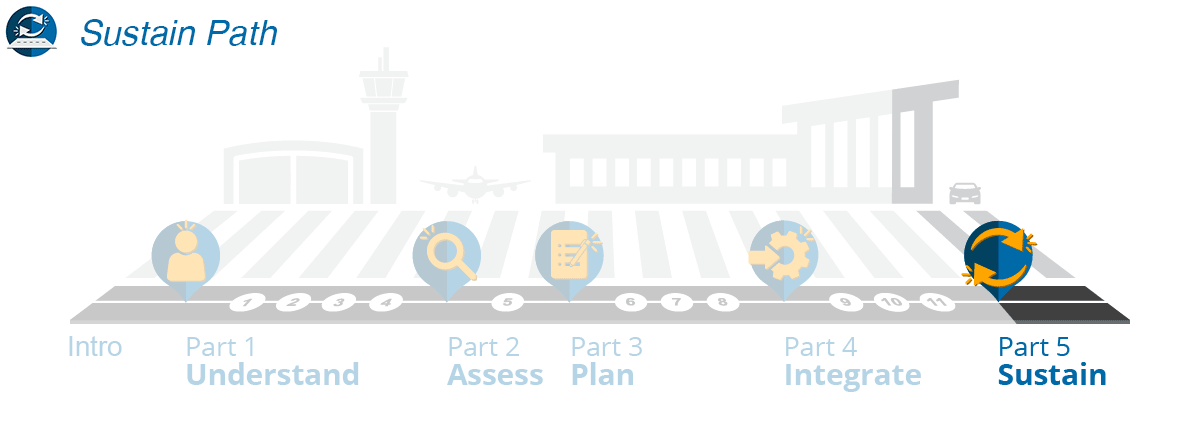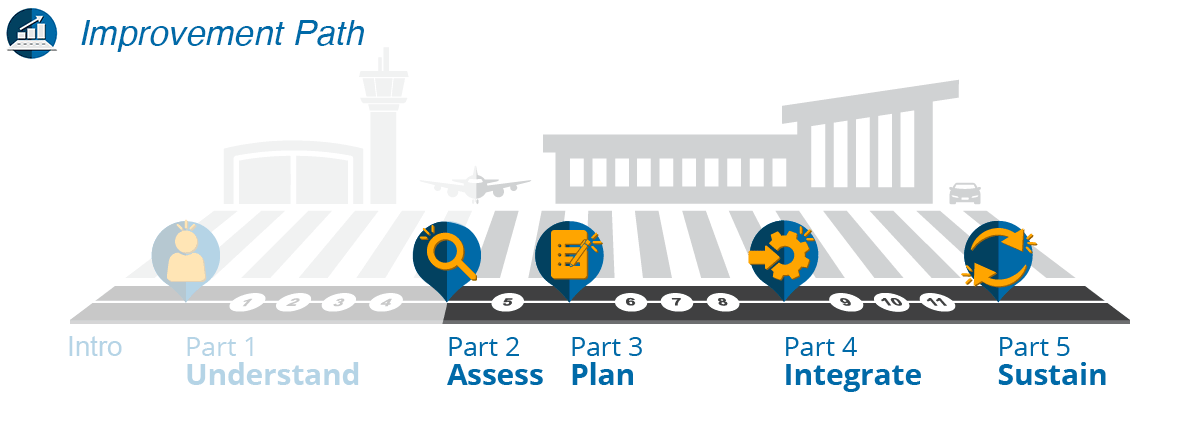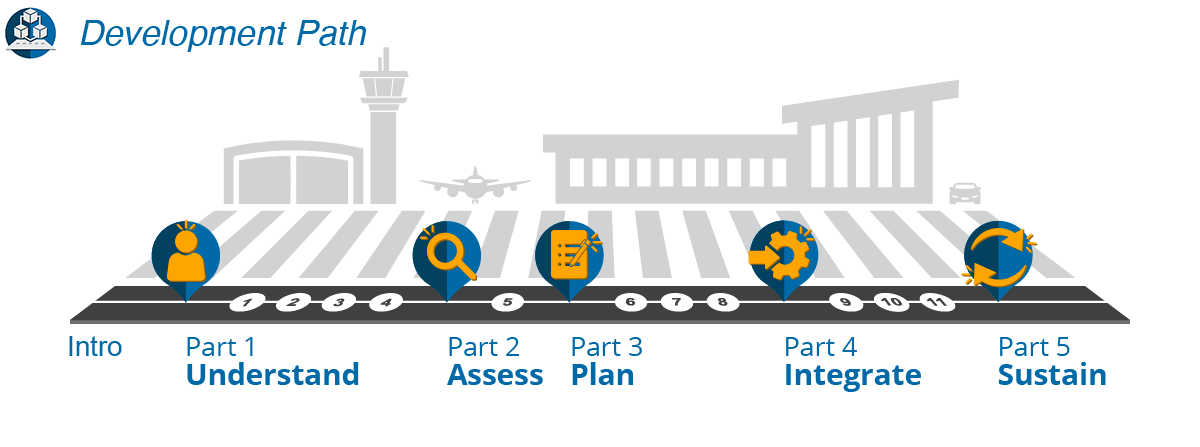
Step 2: Understand Social Media Uses in Emergency Management
Mitigation and Preparedness
The Mitigation and Preparedness phases of emergency response consist of activities typically completed during regular or non-emergency periods. Mitigation activities include identifying potential risks at your airport, collaborating with stakeholders, and developing EM processes, procedures, and plans that reduce risks and minimize loss. Preparedness activities include sustaining and improving operational capability to prevent, respond to, and recover from emergency incidents. This phase also includes the activities of developing plans and procedures for response. There are many resources from organizations such as FEMA that further address these topics, a few of which we have identified in the Resources tab.
Since both of these phases are pre-response, the SM uses during each are very similar. We recommend the following uses under the Mitigation and Preparedness phases:

Listening During Mitigation and Preparedness
Use #1: Listen in on key public SM channels to identify the priority SM profiles you should be sure to follow. For example, you may monitor public SM profiles of air carriers operating at your airport to look for posts referencing your location. Other SM profiles might include local communities and state/federal agencies. Start by identifying those profiles for your facility and then expand outward. Once identified, listening to these organizations' SM profiles can provide trustworthy information on issues that may impact the airport. Step 10: Establish the Social Media Operating Framework includes a worksheet to help you compile a list of SM profiles and topics for which you will be listening.
Use #2: Listen in on public SM channels for chatter regarding how airport users view airport incidents and responses. The social nature of SM channels essentially begs for users to share their opinions about virtually anything. You can use this to your advantage and reduce your risk by identifying problems early and providing an expedited resolution.
Use #3: Listen for external stakeholders (e.g., local, county, or state agencies; hospitals; volunteer organizations) on public SM channels to understand their important issues. Although these stakeholders are off-airport, they can provide valuable resources and may be directly involved in response and support during an event. Assess those following external stakeholders on SM channels to identify population groups they can help you reach during a time of crisis. In listening to these external stakeholders, you should continually evaluate to whom you are listening, looking for new sources of information and updating your plans. During normal activities, practice listening, and work to improve your operating capabilities.

Engagement During Mitigation and Preparedness
Use #1: Engage with airport users who chatter on public SM channels regarding airport operational and EM recommendations. For example, you may use publishing to inform airport users when to arrive at the airport during storms or how to stay up to date on activities around an incident. Whether users are responding to something you published or they are simply sharing their opinion, engaging with them one-on-one through your SM channels is a great way to gather more detailed information. Answering one user's question or concerns in a public forum provides information not only to that individual but also to everyone who is viewing. This interaction can benefit mitigation efforts and help develop a more positive airport reputation. Especially when done publicly, SM engagement demonstrates an airport operator's trustworthiness as an information source on SM channels.
Use #2: Engage with airport users on public SM channels who have posted suggestions or who may have pointed out a potential safety issue. In all EM phases, public SM engagement demonstrates an airport operator's trustworthiness and care for its users. This may also help build your base of followers to reach a larger audience when an incident does escalate.
Use #3: Engage with internal stakeholders (to the airport organization) for better distribution of relevant information and training opportunities. Use these engagements to identify the best channels for your community profile and incorporate these into your planning and exercises.
Use #4: Engage with internal and external stakeholders such as federal/state/local agencies, first responders, and airlines using private and public SM channels as appropriate. This can be a positive way to establish collaboration that is focused on improving procedures involved in integrating SM and EM (SMEM). Additionally, as you collaborate with these entities during all EM phases you will ultimately build trust-a very necessary component for effective emergency response and to mitigating issues ahead of time.

Publishing During Mitigation and Preparedness
Use #1: Publish on public SM channels regarding airport policies and procedures that will be used during irregular operations, weather events, or emergencies. This can be a great help in preparing the traveling public and other airport users for the possibility of an issue, at the same time giving them a sense of calm because they will know what to do. Timely sharing of information can direct people away from trouble and make it easier for those managing the issue to resolve it.
Use #2: Publish on private SM channels to request internal and/or external stakeholder feedback regarding airport EM policies and procedures to improve response to future events. This can initiate the collaborative engagement noted earlier.
Use #3: Publish on public SM channels about developing issues at the airport, providing airport users with actionable information. Should a given issue develop into an emergency, this actionable information will prepare airport users on actions they can take during the emergency. It can also provide the media with relevant information. Once you have published this information, you have many ways to extend its reach. For example, you could install a monitor in public airport areas to display recent updates from the airport public SM channels. You could also use the public address (PA) system and information display systems to let people know that the airport will use public SM channels to release official real-time updates during irregular operation and emergency events.

Reporting During Mitigation and Preparedness
Use #1: Report (organize and distribute) to interested stakeholders on the results of the listening, engagement, and publishing efforts noted above. Daily/shift briefings are an example of where this information could be shared. This sharing could lead to increased awareness for first responders in placing resources to prevent problems. Reporting can also enhance your other SM efforts. For example, by consistently listening during non-emergency situations, you can use reporting to determine a baseline level of SM activity surrounding your airport. This information can then enhance your listening capabilities so as to automatically identify spikes in activity that may indicate a developing emergency.
Use #2: Report (organize and distribute) to appropriate stakeholders on the results of the listening, engagement, and/or publishing efforts noted above. For example, a valuable report might include an analysis of SM user response to your published messages. This information can help you improve your messaging and develop new strategies for reaching your target audience.




